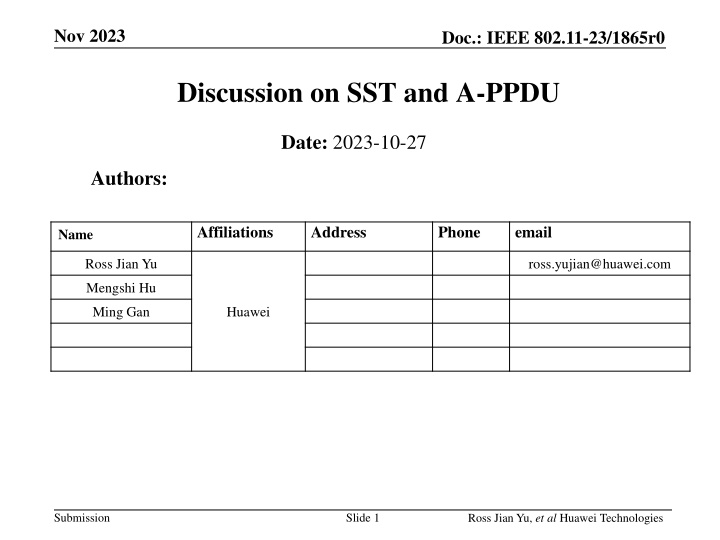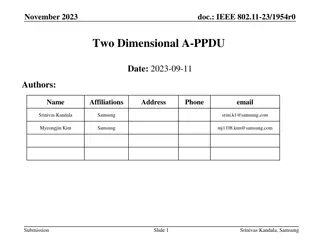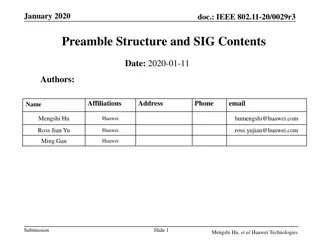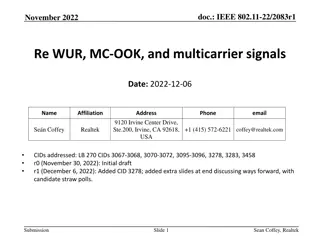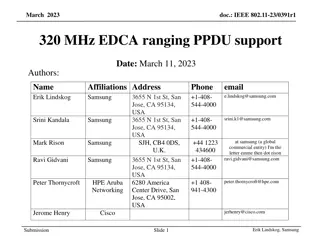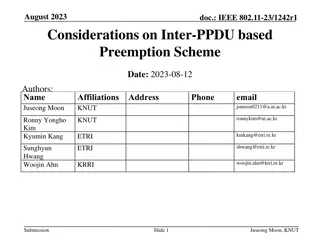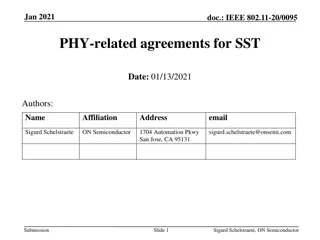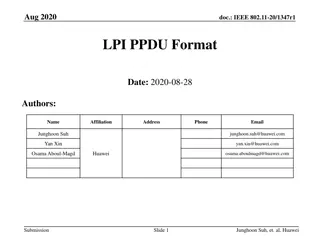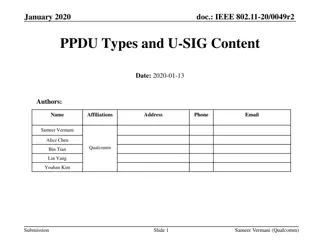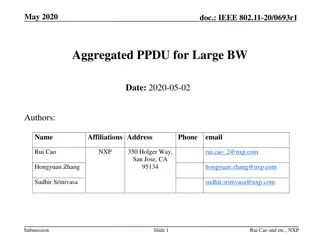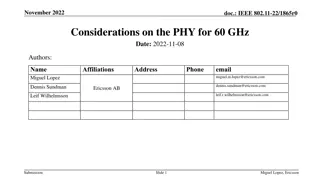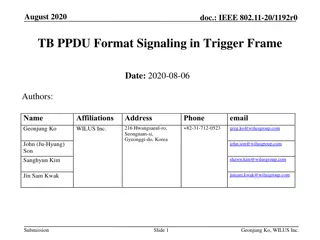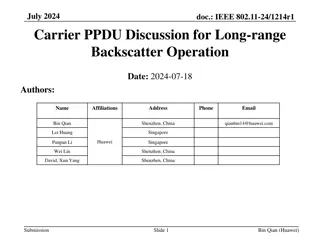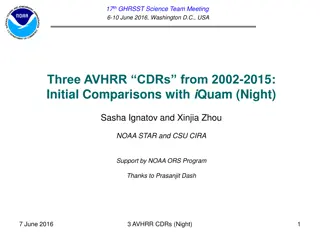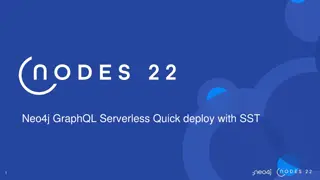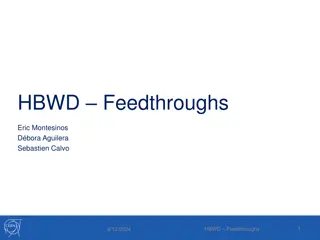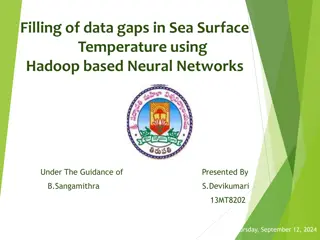Discussion on IEEE 802.11-23/1865r0: SST and A-PPDU
The document discusses the current lack of support for SST on S160 in 11be, highlighting that 11be AP and STA do not support A-PPDU. It explores potential combinations for A-PPDU involving UHR and non-UHR HE and EHT STAs, addressing bandwidth enhancements and benefits of various scenarios. The analysis delves into optimizing bandwidth capabilities and the advantages of different PPDU combinations in the context of IEEE 802.11 standards.
Download Presentation

Please find below an Image/Link to download the presentation.
The content on the website is provided AS IS for your information and personal use only. It may not be sold, licensed, or shared on other websites without obtaining consent from the author.If you encounter any issues during the download, it is possible that the publisher has removed the file from their server.
You are allowed to download the files provided on this website for personal or commercial use, subject to the condition that they are used lawfully. All files are the property of their respective owners.
The content on the website is provided AS IS for your information and personal use only. It may not be sold, licensed, or shared on other websites without obtaining consent from the author.
E N D
Presentation Transcript
Nov 2023 Doc.: IEEE 802.11-23/1865r0 Discussion on SST and A-PPDU Date: 2023-10-27 Authors: Affiliations Address Phone email Name Ross Jian Yu ross.yujian@huawei.com Mengshi Hu Ming Gan Huawei Submission Slide 1 Ross Jian Yu, et al Huawei Technologies
Nov 2023 Doc.: IEEE 802.11-23/1865r0 Agreed SPs for 11be R2 [1] Submission Slide 2 Ross Jian Yu, et al Huawei Technologies
Nov 2023 Doc.: IEEE 802.11-23/1865r0 Agreed SPs for 11be R2 [1] The current situation is that 11be doesn t support SST on S160. In general, 11be AP and STA doesn t support A-PPDU. Whilst in the spec, an EHT non-AP STA capable of 320 MHz supports transmission of an EHT PPDU in S160, with an HE PPDU in P160. Submission Slide 3 Ross Jian Yu, et al Huawei Technologies
Nov 2023 Doc.: IEEE 802.11-23/1865r0 UHR A-PPDU combinations (1/3) Non-UHR HE and EHT STAs don t support A-PPDU. Assuming UHR STA supports A-PPDU, we may have the following possible combinations when the aggregated bandwidth is 160 MHz: As it is optional for non-EHT HE STA to support large bandwidth OFDMA, hence Opt (1) enhances maximum bandwidth from 80 MHz to 160 MHz, twice Tput gain, when there exists 80 MHz capable only non-EHT HE STA. Opt (2) is beneficial if some potential UHR feature makes UHR PPDU better than EHT PPDU in A-PPDU scenario, exact feature or gain needs further study. 80 MHz 80 MHz HE PPDU EHT PPDU HE PPDU (by UHR STA) UHR PPDU (1) (2) 80 MHz HE + 80 MHz EHT/UHR PPDU makes L-length in different 80 MHz different, and will lead to L-SIG Reception error by non-EHT HE STA. HE-SIG-A difference in different 80 MHz may lead to HE-SIG-A reception error, needs further implementation check 80 MHz EHT + 80 MHz EHT or 80 MHz UHR + 80 MHz UHR doesn t show obvious benefits compared with 160 MHz EHT or UHR PPDU. Slide 4 Submission Ross Jian Yu, et al Huawei Technologies
Nov 2023 Doc.: IEEE 802.11-23/1865r0 UHR A-PPDU combinations (2/3) Non-UHR HE and EHT STAs don t support A-PPDU. Assuming UHR STA supports A-PPDU, assuming the maximum bandwidth for UHR is 320 MHz, we may have the following possible 160 MHz + 160 MHz combinations: Opt (a) enhances maximum bandwidth from 160 MHz to 320 MHz, twice Tput gain. Opt (b) is beneficial if some potential UHR feature (e.g., UEQM, higher coding rate) makes UHR PPDU better than EHT PPDU, exact feature or gain needs further study. Compared with Opt (a), Opt (c) is beneficial if some non-UHR EHT STA can transmit EHT TB PPDU in S160 according to 11be spec. Exact implementation status TBD. 160 MHz HE PPDU EHT PPDU HE PPDU 160 MHz UHR PPDU EHT PPDU (by UHR STA) UHR PPDU (a) (b) (c) Other 160 MHz + 160 MHz options include HE+HE, EHT+EHT, UHR+UHR, the gain compared with the above options or a 320 MHz EHT or UHR PPDU are not clear. Submission Slide 5 Ross Jian Yu, et al Huawei Technologies
Nov 2023 Doc.: IEEE 802.11-23/1865r0 UHR A-PPDU combinations (3/3) Non-UHR HE and EHT STAs don t support A-PPDU. Assuming UHR STA supports A-PPDU, assuming the maximum bandwidth for UHR is 320 MHz, we may have the following 80 MHz + 80 MHz + 160 MHz possible combinations: Opt (d) enhances maximum bandwidth from 80 MHz to 320 MHz, Four times Tput gain. Opt (e) doesn t show obvious gain compared with Opt (b). Compared with Opt (d), Opt (f) is beneficial if some non-UHR EHT STA can transmit EHT TB PPDU in S160 according to 11be spec. Exact implementation status TBD. 80 MHz 80 MHz HE PPDU EHT PPDU HE PPDU HE PPDU (by UHR STA) EHT PPDU (by UHR STA) HE PPDU (by UHR STA) 160 MHz UHR PPDU UHR PPDU EHT PPDU (by UHR STA) (d) (e) (f) Other 80 MHz + 80 MHz+ 160 MHz options, and other 80 MHz *4 options, the gain compared with the above options or a 320 MHz EHT or UHR PPDU are not clear. Submission Slide 6 Ross Jian Yu, et al Huawei Technologies
Nov 2023 Doc.: IEEE 802.11-23/1865r0 Preferred combinations As a summary, the current preferred combinations include: 80 MHz 80 MHz HE PPDU HE PPDU (by UHR STA) (1) 80 MHz 80 MHz HE PPDU 160 MHz HE PPDU HE PPDU (by UHR STA) 160 MHz 160 MHz UHR PPDU UHR PPDU (a) (d) Other modes need further study. More options are possible assuming preamble puncturing. E.g., (80 + X + 160)*4 Submission Slide 7 Ross Jian Yu, et al Huawei Technologies
Nov 2023 Doc.: IEEE 802.11-23/1865r0 Signaling for SST (1/2) There exists signaling which moves the non-AP UHR STA to S160 channel. The signaling for SST can be combined with TWT, or exists separately at the beginning of a TXOP. With preamble puncture, anchor channel, or temporary primary channels need to be defined for each 80 MHz subchannels. Parks on the channel in the SP phase and waits for AP scheduling information. SP STA in doze TWT request TWT reponse P20MHz STA AP Submission Slide 8 Ross Jian Yu, et al Huawei Technologies
Nov 2023 Doc.: IEEE 802.11-23/1865r0 Signaling for SST (2/2) There exists signaling which moves the non-AP UHR STA to S160 channel. The signaling for SST can be combined with TWT, or exists separately at the beginning of a TXOP. With preamble puncture, anchor channel, or temporary primary channels need to be defined for each 80 MHz subchannels. Content Channel Mode UHR-SIG Receive Location Content Channel Mode UHR-SIG Receive Location STA 1 ID STA 2 ID Content Channel Mode and UHR-SIG Receive Location OM 1st 20MHz L- ACK from STA1 (TB) UHR-SIG CC1 ... L-preamble+U-SIG preamble Content Channel Mode and UHR-SIG Receive Location OM L- UHR-SIG CC2 2nd 20MHz L-preamble+U-SIG preamble Data to STA1 ACK from STA1(TB) Content Channel Mode and UHR-SIG Receive Location OM L- UHR-SIG CC1 3rd 20MHz L-preamble+U-SIG preamble Content Channel Mode and UHR-SIG Receive Location OM L- UHR-SIG CC2 4th 20MHz L-preamble+U-SIG preamble ACK from STA2 (TB) UHR-SIG CC1 Content Channel Mode and UHR-SIG Receive Location OM 5th 20MHz L- ... L-preamble+U-SIG preamble Data to STA2 ACK from STA2(TB) 6th 20MHz UHR-SIG CC2 Content Channel Mode and UHR-SIG Receive Location OM L- L-preamble+U-SIG preamble Content Channel Mode and UHR-SIG Receive Location OM L- UHR-SIG CC2 7th 20MHz L-preamble+U-SIG preamble Punctured Punctured 8th 20MHz Submission Slide 9 Ross Jian Yu, et al Huawei Technologies
Nov 2023 Doc.: IEEE 802.11-23/1865r0 Signaling for non-TB transmission Within A-PPDU, each PPDU indicates its own bandwidth. Moreover, the aggregated bandwidth, or exact bandwidth combinations may also be signaled (needs further study). HE MU- 1 HE-SIG-A BW=80MHz L-STF L-LTF L-SIG RL-SIG HE-SIG-B HE-STF HE-LTF Data PE HE MU- 2 HE-SIG-A BW=80MHz L-STF L-LTF L-SIG RL-SIG HE-SIG-B HE-STF HE-LTF Data PE UHR MU- 3 U-SIG BW=160MHz 80-80-160 UHR- STF L-STF L-LTF L-SIG RL-SIG UHR-SIG UHR-LTF Data PE Submission Slide 10 Ross Jian Yu, et al Huawei Technologies
Nov 2023 Doc.: IEEE 802.11-23/1865r0 Signaling for TB transmission (1/2) 802.11be already defines a single trigger frame which can enable A-PPDU of HE + EHT PPDU, whilst the spec disallows the AP to trigger such combinations. EHT PPDU can be simply changed to UHR PPDU by changing PHY version ID, and hence Opt (a) can be supported . Regarding the preferred mode, some further work is needed to support Opt (1) and Opt (d). TB PPDU 3 160 MHz TB A-PPDU TF for TB PPDU 1-3 TB PPDU 2 80 MHz TB PPDU 1 80 MHz Submission Slide 11 Ross Jian Yu, et al Huawei Technologies
Nov 2023 Doc.: IEEE 802.11-23/1865r0 Signaling for TB transmission (2/2) An alternative way of transmitting trigger frame is to use DL A-PPDU to transmit several trigger frames, one trigger corresponds to one TB PPDU. Need to define temporary primary channel. Moreover, the aggregated bandwidth, or exact bandwidth combinations may also be signaled (needs further study). TF 3 for TB PPDU 3 TB PPDU 3 160 MHz TB A-PPDU A-TF TF 2 for TB PPDU 2 TB PPDU 2 80 MHz TF 1 for TB PPDU 1 TB PPDU 1 80 MHz Submission Slide 12 Ross Jian Yu, et al Huawei Technologies
Nov 2023 Doc.: IEEE 802.11-23/1865r0 Summary In this contribution, different possible A-PPDU combinations are firstly discussed. The preferred modes at this stage are shown. Signaling regarding SST, non-TB transmissions and TB transmissions are discussed in high level. Detailed signaling, sequence design, phase rotation, spectral mask etc. can be further studied. Submission Slide 13 Ross Jian Yu, et al Huawei Technologies
Nov 2023 Doc.: IEEE 802.11-23/1865r0 References 1. 11-20-1935-66-00be-compendium-of-straw-polls-and-potential-changes-to- the-specification-framework-document-part-2 2. 11-22-1416-01-00be-discussion-on-sst-and-a-ppdu Submission Slide 14 Ross Jian Yu, et al Huawei Technologies
